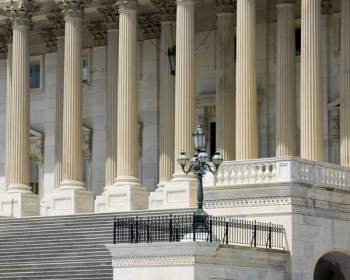
Rules of the Court, Number of Judges, and Appointment of Chief Justice

Popular In Constitution
Purpose Of Lifetime Appointment And Pros And Cons Enumerated Powers Bicameral Legislature Background Article 3 Of The Constitution We The People 1st Amendment Who Wrote The Constitution Judicial Review Equal Protection Clause Three Fifths Compromise 10th Amendment 5th Amendment
The stipulations contained for the Supreme Court in the Constitution are, like much else to be found in the document, broadly and briefly defined. Structural and procedural questions of the Court's nature, for instance, are largely overlooked by the relevant provision, Article III, "The Judicial Branch", which instead sets out the basic nature of the Court.
Practical questions of Court procedure, such as the number of Justices to be included and the role of the Chief Justice, have largely been accorded to Congress and to the Court itself. These provisions began with the first Congressional legislation, the Judiciary Act of 1789, created three circuits (Eastern, Southern, and Middle) and within these thirteen districts. The changing needs of the country and evolution of its political culture have led to changes in established practice.
As with other questions, the number of Justices in
the Supreme Court is not dealt with the Constitution. When the Court was first
established, it consisted of six members, comprising the Supreme Court Chief Justice
and five other Associate Justices. Without any fixed requirement for this
number, however, it frequently changed, with six shifts in all. The last such
change, in 1869, set the number at nine, which has continued in American
judicial practice up to the present.
The appointment of the Supreme Court Chief Justice
is accorded particular weight in the American political scene due to the
influence which the individual selected is likely to wield and the lengthy term
which he or she is likely to hold. This precedent was established for the Court
by the fourth Chief Justice appointed, John Marshall, who
presided over the Court for a still unmatched thirty-four-year term, during
which he reconfigured the Supreme Court as a decisively important part of the
American political scene. As with the subordinate Associate Justices, the
Supreme Court Chief Justice is nominated by the President and approved by
Congressional voting.
Despite the President's decisive role in selecting
nominees for Chief Justice, at the root of the office is a Constitutional
stipulation for the limitation of executive branch power. Article III of the
Constitution, as is generally devoted to the subject of "The Judicial
Branch", does not consider the existence of a Chief Justice or any other
hierarchically defined section of the Court. The Supreme Court Chief Justice
office is established, rather, by the Constitution's first Article, in Clause 6
of Section 3, with its allocation of the responsibility for presiding over
Presidential impeachments to the "chief justice," to which there is
no other reference.
Without any preconditions being set on the relationship between the Supreme Court Chief Justice and the Associate Justices, the selection of a nominee may either elevate one of the Associate Justices to the position or pull in an outside nominee who has not yet served on the bench. The death of a Supreme Court Chief Justice can be met with a provisional replacement by one of the currently sitting Associate Justices until the President and Congress succeed in officially placing a new person in the position.
NEXT: Slavery Overview




















